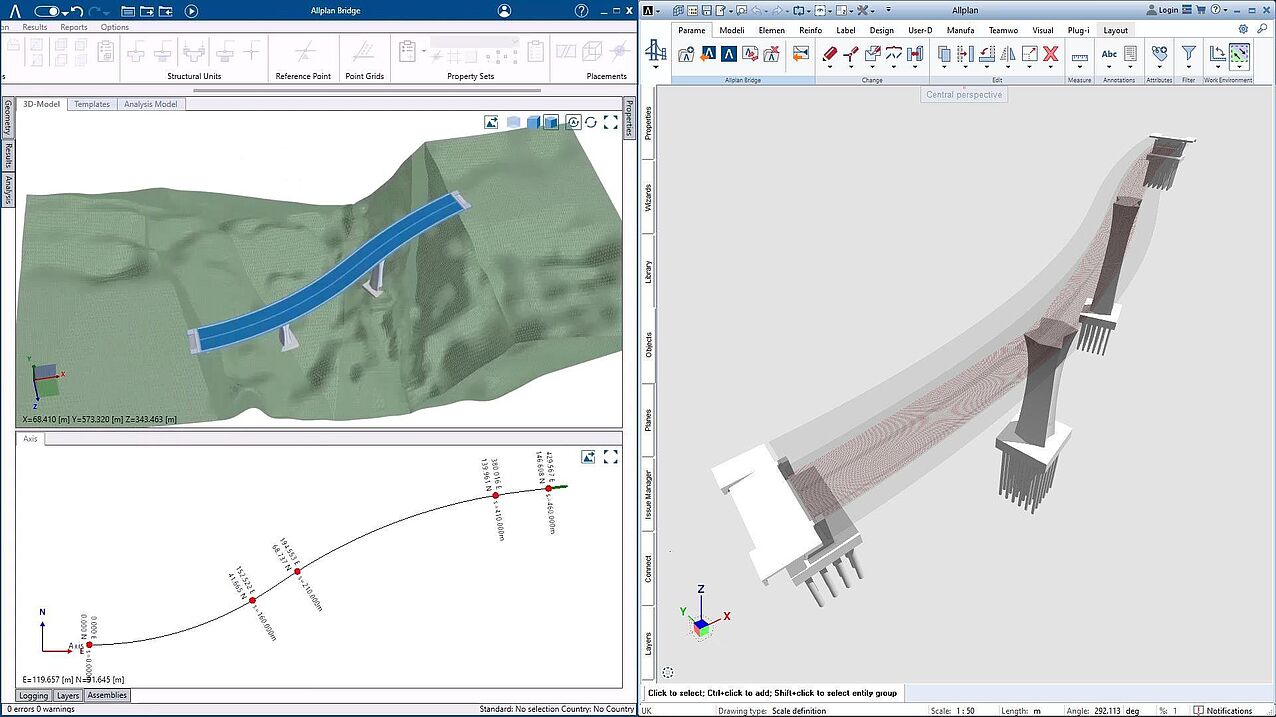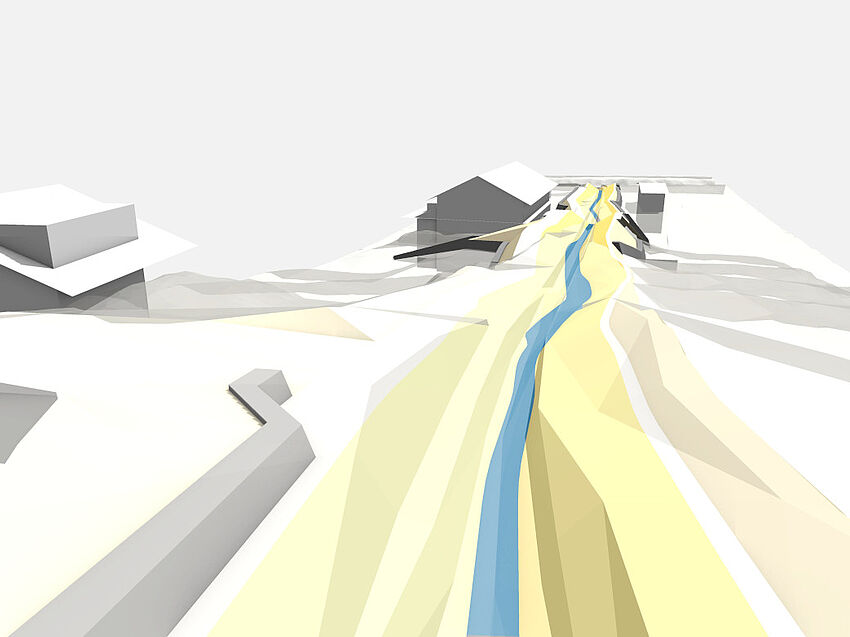The architecture, engineering, and construction (AEC) industry is ever evolving, and so are the demands on bridge engineers to deliver innovative, safe, and cost-effective projects. ALLPLAN Bridge 2024 introduces a paradigm shift in how these challenges can be overcome. With its cutting-edge capabilities, this latest version empowers bridge engineers to optimize their design and construction processes like never before.
Accelerating Design to Build for Bridge Engineers
For maximum efficiency, a unified tool that covers the entire project lifecycle is paramount. ALLPLAN Bridge 2024 is a comprehensive solution for all phases of bridge engineering – from preliminary designs and structural analysis to precast manufacturing and construction planning. The software’s innovative features not only facilitate powerful and automated modeling but also offer extended structural analysis capabilities. These streamlined workflows enable engineers to optimize their designs, deliver projects earlier, and maximize value for their clients.
Key Features in ALLPLAN Bridge 2024
ALLPLAN Bridge 2024 offers a suite of new and upgraded features that serve as a comprehensive toolset specifically engineered for bridge design and construction. From accelerating design processes with terrain visualization to streamlining code compliance via additional national annexes, this version is an indispensable asset for bridge engineers striving for speed, precision, and excellence.
Terrain Visualization with Parametric Referencing: For Streamlined Design Processes
ALLPLAN Bridge 2024 brings innovation to the forefront with its Terrain Visualization feature, allowing for a seamless integration of complex environmental variables – such as local topography and obstacles – right into the design interface. This visual tool not only aids in aesthetic and functional design but also provides an invaluable resource for modeling and checking clearances.
What sets this feature apart is its parametric nature. Critical substructural components like piers and piles can be referenced directly to an automatically generated terrain axis. Any design changes made to elements like girder height will automatically adjust associated structures, like pier height, thus offering a dynamic and time-saving solution for iterative design adjustments.
Parametric Reinforcement Connection: The New Standard in Speed and Precision for Rebar Detailing
The constant challenge when creating BIM reinforcement models and detailing drawings is balancing quality, productivity, and profitability. ALLPLAN Bridge 2024 introduces a groundbreaking solution to this problem by fusing two cutting-edge parametric technologies – ALLPLAN Bridge’s parametric modeling solution and parametric reinforcement objects (PythonParts) in ALLPLAN.
This amalgamation allows for reinforcement sets in ALLPLAN Bridge to be parametrically connected. The geometry of the longitudinal, shear, and torsion reinforcement isn’t the only information transferred; specifics like the position of bars, number of bars, and bar diameters are also included. The result is a fully parametric design-to-build workflow that drastically reduces the potential for errors while enhancing speed and accuracy.

Free Parametric Modeling 2.0: The Next Evolution in Bridge Modeling Versatility
ALLPLAN Bridge has historically offered engineers multiple modeling methods, each serving unique requirements of complex bridge design. While the initial methods were effective for elements following the axis of the bridge, the advent of Free Parametric Modeling in version 2023 provided a dynamic approach for non-axial elements. The 2024 version significantly upgrades this feature, offering an expansive capability that allows any modeling element – be it a girder, pier, or deck – to be extracted into a 3D body for freeform use, while retaining full parametric integrity.
The versatility of Free Parametric Modeling 2.0 extends further through enhanced capabilities such as Boolean operations and template utilization. The latest improvements enable the use of multiple prism elements in a single prism template, combining them using Boolean operations. This adaptability allows for the creation of more complex structures like abutments, which can be easily replicated and positioned within the bridge model. These templates can also be exported for use in other projects, streamlining the design process.
One notable addition is the Body Containers feature, which introduces a localized coordinate system for an enhanced modeling workflow. Within this system, 3D docking points can be strategically positioned, permitting the placement of multiple 3D bodies. This innovation amplifies the software’s capacity for accommodating complex objects, offering engineers an unparalleled level of flexibility and efficiency in their design process.

Further National Annexes to EN: Tailored Compliance with Key National Standards
ALLPLAN Bridge 2024 expands its code-based design module by incorporating three new national annexes. Now, Germany (DIN EN), France (NF EN), Spain (UNE EN), the UK (BS EN), Austria (ÖNORM EN), and Poland (PN EN) are all covered. This enhancement ensures that engineering projects align seamlessly with the unique regulatory frameworks of these countries. All limit states are comprehensively addressed through annex-specific limit values or methods, which are also conveniently cited in generated reports. This update significantly simplifies the process of adhering to multiple national standards, providing a streamlined and compliant design experience.

Automatically Derived Calculation Actions: Elevating Precision in Balanced Cantilever Construction
Balanced cantilever construction is a frequently used technique in the bridge engineering field, where meticulous calculations are indispensable for accurately modeling structural and time-dependent behavior. ALLPLAN Bridge 2024 introduces a game-changing feature – the new balanced cantilever task – that simplifies this complex process. It requires only an object-oriented input of geometric data for the form traveler and the construction timetable, all housed within a single, user-friendly interface. From this minimal input, the software automatically generates the calculation actions, such as applying and moving the form traveler, segment assembly, self-weight application, and pre-stressing tendons. Moreover, it accurately accounts for factors like creep and shrinkage throughout the construction phases. This automated approach not only eliminates the possibility of manual errors but also significantly accelerates the project timeline.
Building Better Bridges with ALLPLAN Bridge 2024
In a sector where precision, efficiency, and adaptability are not just ideals but necessities, ALLPLAN Bridge 2024 emerges as a robust tool for bridge engineers. This latest version encapsulates a holistic approach to bridge design and construction, combining parametric design capabilities, a seamless design-to-build workflow, and compliance with international codes. From the inception of preliminary designs to the detailing stages and on to construction planning, ALLPLAN Bridge 2024 is a one-stop solution for all your project needs. Download a free, 14-day trial and see how you can build better bridges faster and more efficiently than ever before.




